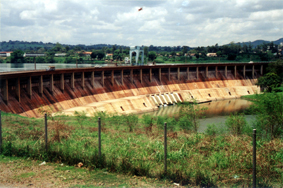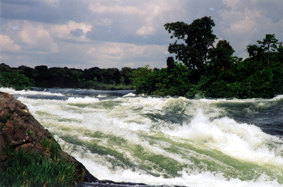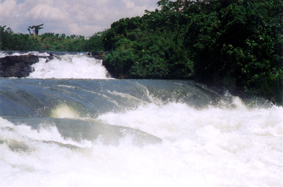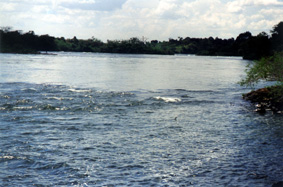- Ajegunle Day – a Photographic Essay
- Bujagali Falls: Magic on the Nile to Disappear?
Bujagali Falls: Magic on the Nile to Disappear?
Some ten kilometres below Lake Victoria, Africa’s largest lake and source of the River Nile, lie the little-known but stunningly beautiful Bujagali Falls. Although lacking a single massive drop of the kind that generally earns waterfalls their fame, the Bujagali are distinctive because of the sheer volume of water cascading over the series of low rapids that would otherwise be unremarkable. The luxuriant vegetation covering the river banks and islands, and the startling diversity of bird life attracted by the multitude of fish, complete the stunning vista, as illustrated in the photographs. Water entering the White (or Victoria) Nile – known locally as Omugga Kiyira – from the Lake takes fully three months to flow the 6400 km northwards to the Mediterranean Sea.
This peaceful corner of Uganda, not far from the country’s second city of Jinja, might well have remained relatively obscure, save to local residents and the young travellers frequenting nearby campsites to expe rience the excitement of white water rafting and other forms of low-impact ecotourism. However, construction of a second hydro-electric dam near the falls, now under way, has thrust the area into the international spotlight. The powers that be deem the ageing Owen Falls Dam, completed in 1954 at the source of the Nile, inadequate to meet the region’s increasing demand for electricity, and see the 200-megawatt Bujagali Dam as a source of lucrative export revenue, mainly to neighbouring Kenya.
rience the excitement of white water rafting and other forms of low-impact ecotourism. However, construction of a second hydro-electric dam near the falls, now under way, has thrust the area into the international spotlight. The powers that be deem the ageing Owen Falls Dam, completed in 1954 at the source of the Nile, inadequate to meet the region’s increasing demand for electricity, and see the 200-megawatt Bujagali Dam as a source of lucrative export revenue, mainly to neighbouring Kenya.
However, this need is hotly contested by local and international NGOs and environmental activists. The basis of their opposition is a combination of the generic problems of expensive, large dams and the particular impact that it will have on the outstanding natural beauty of the upper Nile. Already the Ripon Falls upstream have been lost – submerged in 1947 as the water level rose behind the Owen Falls Dam. A second dam would irreparably alter the appearance and ecology of the area, and also wipe out the basis of the lucrative ecotourist economy.
Moreover, it is now widely accepted that smaller dams and weirs, costing far less and without the massive environmental and social impacts, can generate comparable amounts of electricity. This was affirmed by the report of the respected World Commission on Dams in 2000, which also highlighted that the costs of such schemes may outweigh the benefits, although it is disproportionately the poor and the environment who bear most of the costs.
and the environment who bear most of the costs.
As with so many large dam schemes, the controversies do not readily go away. Suspicions that vested interests rather than objectively tested need lie behind the construction of Bujagali were fuelled in September 2002 when the Washington Post reported the sacking of John M. Fitzgerald, an American lawyer working as an environmental policy analyst for the US Agency for International Development (USAID). His misdemeanour was apparently to highlight ‘environmental problems, gross waste and mismanagement’ in his review of US-backed public bank loans to overseas infrastructure projects, including Bujagali, and then to challenge other staffers who had toned down his criticisms. The article, reprinted in the Ugandan independent daily newspaper, The Monitor, on 25 September, caused quite a stir locally. Fitzgerald reportedly warned that – as widely claimed in Uganda – the Bujagali project is subject to allegations of corruption and that cheaper, cleaner and more efficient alternatives had not been considered.
There is now renewed hope is that this disclosure will a dd to existing pressures for a halt to construction, most likely through a cessation of funding by the World Bank and its international partners, at least until a full and unbiased appraisal has been conducted and the alleged corruption investigated and addressed.
dd to existing pressures for a halt to construction, most likely through a cessation of funding by the World Bank and its international partners, at least until a full and unbiased appraisal has been conducted and the alleged corruption investigated and addressed.
An important development was the judgement by the Uganda High Court on 12 November 2002, that the hitherto secret Power Purchase Agreement (PPA) between the government and the private developer (the US-based AES Corporation) must be made public. The International Rivers Network then commissioned an independent study of the PPA. This shows that the dam project will, if completed to plan, cost Uganda some US$280 million over the odds, and that the PPA contains several unusual clauses damaging to Uganda. For further details, see World Rivers Review 17(5/6), December 2002 and the International Rivers Network website.
22 November 2002
Update January 2009: The World Rivers Review reported in December 2007 that the World Bank and European Investment Bank finally approved the Bujagali project in April, at an estimated cost of US$799, despite the strong evidence of flaws in the economic arguments and the Environmental Impact Assessment, with respect particularly to the threats to local fisheries and health of Lake Victoria. Consequently, in March 2007, Uganda’s National Association of Professional Environmentalists filed complaints with the World Bank’s Inspection Panel (WBIP) and the EIB alleging violations of their own policies. The WBIP submitted its extensive report in August 2008, confirming many of the flaws and problems with the EIA and other elements of the appraisal, and making extensive recommendations that should be met before any further World Bank funds are released. The Bank’s management produced a 51-page response in November 2008, stating that stakeholder commitments would be followed up through an Action Plan that would include establishing a project monitoring committee, implementing a management plan for cultural resources, and disclosing hitherto confidential reports produced by independent social and environmental experts. The response document was due for discussion by the Bank’s Board in December. The outcome of that discussion is not yet known. These documents and other materials can be found on the International Rivers’ website (www.internationalrivers.org) by typing ‘Bujagali’ into the search facility.
Update February 2004: Although in early 2004, the World Bank denied any current involvement in the dam, leaked documents and some media reports suggest that it was still instrumental in trying to revive the project and find alternative financial backing (Source, IRN World Rivers Review, 19(1), Feb 2004).
Update October 2003: The International Rivers Network (IRN) undertook a review of the World Bank's economic evaluation of the Bujagali Dam, and concluded that ´Contrary to [the Bank's] conclusions, geothermal and bagasse power sources together have the potential to supply all Uganda's grid power needs over at least the next decade wish similar or lower costs and less vulnerability to climate change and other risks.´
However, both the Bank and the Ugandan government have been urgently trying to find alternative financial backers for the dam in the wake of AES's withdrawal, rather than launch a full, holistic assessment of the country's energy needs and alternative sources as proposed by local groups. Moreover, the national power utitilty reported in 1996 that up to a third of electricity currently generated in Uganda was lost in transmission across the inefficient and dated national grid. Upgrading of the grid, coupled with exploitation of other energy sources, could provide very viable and much cheaper alternatives. As the IRN conclude: ´The World Bank has not only flaunted the recommendations of the WCD on Bujagali, but it appears bent on building this white-elephant of a dam despite numerous options that might better meet the country's long-term development goals.´ (Source IRN World Rivers Review , 18(5), October 2003).
Update August 2003: The US-based energy giant AES pulled out of this controversial project last week, taking a $75 million loss. The proposed $530 million dam on the Nile River was a key element in the World Banks' efforts to privatise the Ugandan energy sector. The controversy over this project was fuelled not only by the lack of competitive bidding, but also by the project's extraordinarily high cost to the people of Uganda. The project also met with stiff opposition from local organizations concerned that the dam would drown the culturally important Bujagali Falls, and who urged the government to preserve the falls and look to less-harmful and cheaper energy alternatives. (Source: International Rivers Network news update, 19 August).
Key References
McCully, P. (2002) Silenced Rivers; the ecology and politics of large dams, 2nd edn. Zed Books, London. This expanded and updated edition of the acclaimed study published in 1998 includes discussion of the report of the World Commission on Dams.
Roy, A. (2000) The Cost of Living. Flamingo, London. This little paperback by the world renowned Indian author, Arundhati Roy, is an impassioned critique of the notorious Narmada River scheme in India is being forced through despite sustained local and international opposition and the large number of people being forcibly resettled.
Simon, D. (2000) Damm(n)ed Development? Third World Planning Review 22(2): iii-ix. A short potboiler on the large dam issue, including the notable success of the Assembly of the Poor alliance in Thailand in its campaign to force the Thai government to open the sluice gates of the recently completed Pak Mun Dam in order to save fish populations in the river and the livelihoods of the many local people dependent on that fishery.
World Commission on Dams (2000) Dams and Development; a new framework for decision-making. Earthscan, London and Sterling, VA. Now a standard reference work on the pros and cons of large dams, and the way in which new proposals should be appraised in themselves and in relation to alternative schemes in order to take full account of the perceptions and needs of the diverse stakeholder groups.
